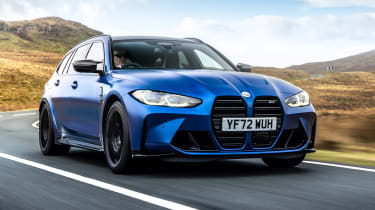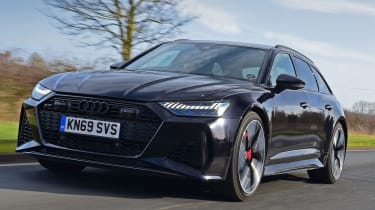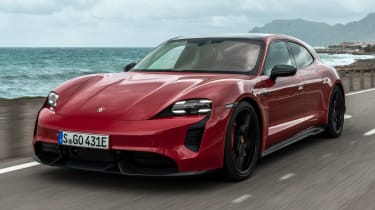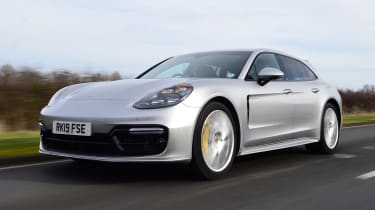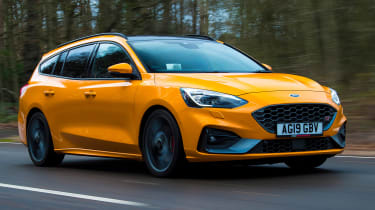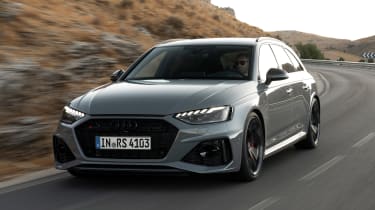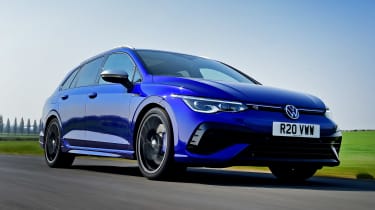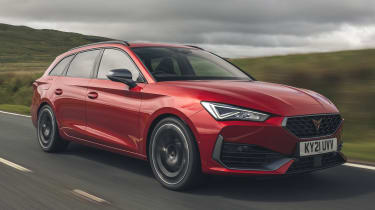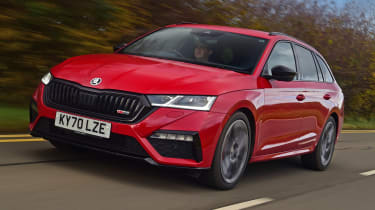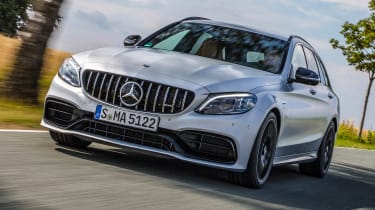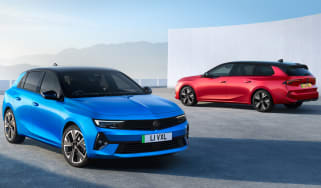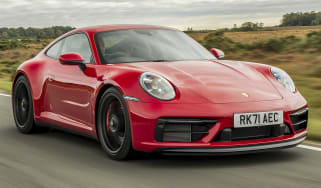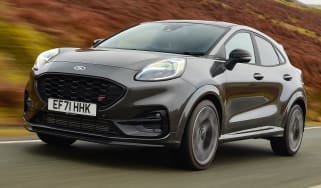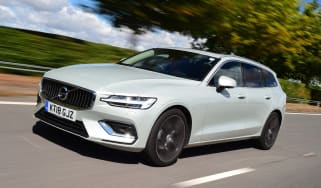Top 10 best fast estate cars 2023
Blistering pace and excellent space, here are the best fast estate cars in the world
These days, those wanting to blend an abundance of practicality with performance tend to go for a fast SUV. We can see why - there’s an incredible amount of choice in the market, and incredible chassis technology means these kinds of cars handle far better than you think they might, considering the ride height and weight usually involved.
But in many cases, there will be an equivalent fast estate car from the same manufacturer which is lower and lighter, thus even quicker and sharper handling, not to mention better looking. The fast estate segment isn’t what it once was, but there are still some amazing options out there for those who don’t want to go with the SUV heard.
The best fast estate cars
- BMW M3 Touring
- Audi RS 6 Avant Performance
- Porsche Taycan Sport Turismo
- Porsche Panamera Sport Turismo
- Ford Focus ST Estate
- Audi RS 4 Avant Competition
- Volkswagen Golf R Estate
- Cupra Leon Estate
- Skoda Octavia vRS Estate
- Mercedes-AMG C63 S E-Performance
Below you’ll find our pick of the best fast estates currently on sale…
1. BMW M3 Touring
This is the car we didn’t think BMW would ever make. The closest the German brand came was with a prototype estate version of the E46 M3, but finally, a production M3 Touring exists, based on the current ‘G80’ M3 Competition. And it’s magnificent.
Although it’s a fair bit heavier than the M3 Comp saloon, you don’t notice the extra bulk behind the wheel. In fact, the driving experience is much the same, which is good news, as the four-door version is a car that hides its heft very well, changing direction with incredible enthusiasm.
You get just as much boot space as a standard 3 Series Touring - 500 litres with the rear seats up, 1,510 with them folded flat - and making it even more useable, it has BMW’s xDrive system to enable the 3.0-litre twin-turbo straight-six’s 503bhp to be successfully deployed - whether it’s wet or dry out. If you’re feeling brave, there’s a rear-wheel drive mode, too.
2. Audi RS 6 Avant Performance
Although Audi didn’t invent the fast estate, it probably did more for the genre than any other marque in the early years. The RS 2, co-developed with Porsche, showed Audi wasn’t mucking around, and that car launched a hot wagon dynasty which continues to this day in the shape of the RS 6 Avant.
The RS 6 has always been enormously fast in a straight line, and for one generation, Audi even fitted a twin-turbo V10. But what marks the current ‘C8’ out from its predecessors is it’s engaging to drive in a way that early, more inert-feeling RS 6s simply aren’t. What’s more, Audi has made the C8 even better with the launch of the RS 6 Performance.
For this version, Audi has extracted an extra 21bhp and 50Nm of torque from the car’s 4.0-litre twin-turbo V8, giving new figures of 621bhp and 850Nm for a 3.4sec 0-62mph time. You can also hear that eight-cylinder engine better than before in the cabin, thanks to the removal of 8kg of soundproofing.
3. Porsche Taycan Sport Turismo
You’ll find it far easier to find a fast electric SUV than a fast electric estate, but thankfully, Porsche does make something to tick the latter box in the form of the excellent Taycan Sport Turismo, also available as a more adventurous Cross Turismo. There are numerous powertrain options, none of which could be described as slow - even the base car will do 0-62mph in 5.4 seconds.
The GTS ST is probably the sweet spot, with just under 600bhp from its dual-motor powertrain making for a 0-62mph time of 3.7 seconds. At the pointy end of the scale is the Turbo S which does the same in an astonishing 2.8 seconds, although you pay a lot of money to go that fast - at £143,400 it’s getting on for double the price of the entry-level Taycan ST.
Just being quick in a straight line wouldn’t be enough for a Porsche, so Stuttgart has strived to make the Taycan just as fun to steer as the company’s petrol-engined cars and largely succeeded - this is probably the best-driving EV out there right now. It’s not as practical as we might have liked, though, with a modest 446/1,200-litre boot up back.
4. Porsche Panamera Sport Turismo
If you’re not ready for an EV, Porsche does also have a combustion-engined wagon in its ranks in the form of the Panamera Sport Turismo. It looks fabulous, drives excellently, is available with a huge variety of engines, and in most guises has more boot space than the Taycan ST.
Entry-level versions come with twin-turbo V6s, but to make the most of the Panamera’s fine chassis, you really want to go for a V8, which is a 4.0-litre twin-turbo shared with the RS 6 we spoke about earlier. The 472bhp GTS will be fast enough for most, but for those wanting more, there’s a Turbo S kicking out a mighty 620bhp for a 3.1-second 0-62mph time.
There are also plug-in hybrid options that electrify each of these engines, but they are quite heavy, and lose some boot space due to the packaging of the battery.
5. Ford Focus ST Estate
The Ford Focus ST Estate was destined to be a great car. We rate the regular Focus wagon very highly, and the same goes for the ST hatchback, so it should come as no surprise that combining the two results in something quite special at a fairly reasonable price.
Under the bonnet is a 2.3-litre inline-four ‘Ecoboost’ engine derived from the unit found in the last-generation entry-level Mustang, here making 276bhp and 420Nm. This is deployed to the road very effectively via an electronically controlled locking differential, which also helps fight understeer in especially committed cornering.
It’s not quite the handling hero the smaller Fiesta ST is, but we can let that slide considering the hot Focus isn’t far off, yet has a load capacity of up to 1,620 litres.
6. Audi RS 4 Avant Competition
The other fast Audi estate legend which has its own incredible lineage is the RS 4. The original B5 version used a twin-turbo V6 with a then obscene-sounding 375bhp output, and after a two-generation affair with V8s, the RS 4 is back with the same engine configuration as before.
This time it’s a 3.0-litre unit co-developed with Porsche, which develops 444bhp to be sent to - of course - all four wheels via a quattro all-wheel drive system. That figure is a long way down on what the BMW M3 Touring manages, and the RS 4 isn’t as engaging to drive, either. But the excellent RS 4 Competition run-out special closes the gap with an array of chassis tweaks, a reduction in soundproofing, a recalibrated gearbox and various carbon fibre addenda.
What makes the RS 4 particularly cool is, like most of its predecessors and almost all generations of the RS 6, it’s only available as an ‘Avant’ estate.
7. Volkswagen Golf R Estate
On paper, the latest-generation version of this car sounds much like the old one. It uses pretty much the same engine as the Mk7 version with only a slight increase in power, it’s still all-wheel drive, and it even looks pretty similar. The Golf R has a new trick, though, in the form of a torque vectoring system which can send up to 100 per cent of engine torque to one wheel.
So, when cornering enthusiastically, you can actually feel the rear end of this car move around a little, particularly if you’re in the estate version which has a little more weight back there. There’s even a ‘drift mode’, although we’re not sure where you’d use it.
In terms of practicality, you do lose a little bit of space relative to the normal Golf Estate due to the presence of the all-wheel drive system, but there’s a sizeable 611-litre space to fill with your latest flatpack furniture purchases.
8. Cupra Leon Estate
For the current-generation car, the SEAT Leon Cupra has morphed into the Cupra Leon. With that branding change has come new powertrain options - as before the wagon can be specced with a circa-300bhp 2.0-litre inline-four engine, but now there’s also the option of a 242bhp plug-in hybrid based around a 1.4-litre engine, a 2.0-litre unit with a much more modest 187bhp, and a 1.5-litre motor putting out only 148bhp.
Only the first two versions can be considered ‘fast’, but if you’re going for a Cupra Leon, we reckon you should do things ‘properly’ and go for the most powerful pure petrol model. It comes with all-wheel drive as standard, making for great straight-line performance that can be enjoyed in both the wet and dry. It’s also an exciting car with which to dispatch a set of nice bends, although it misses out on the ‘drift mode’ featured on the related Golf R.
9. Skoda Octavia vRS Estate
If the Cupra Leon and VW Golf R are a little too spicy for you, the Skoda Octavia vRS could be just the ticket. It’s one of the most sensible, pragmatic performance cars on sale even as a hatchback, and in estate form, it’s especially handy thanks to a whopping 660-litre boot.
Although it won’t thrill quite like some of the other cars on this page, it’s still a fun and capable option, making good use of the ubiquitous ‘EA888’ 2.0-litre inline-four also found under the bonnets of the Golf R and Cupra Leon. Here, it develops 242bhp, which is deployed through the front wheels via a manual gearbox (or an optional dual-clutch automatic) and a clever electronically controlled locking differential.
Not sensible enough? There’s also a 197bhp diesel-powered vRS and a (temporarily unavailable) 1.4-litre plug-in hybrid, but our preference would be the 2.0 litre.
10. Mercedes-AMG C63 S E-Performance
The old C 63 used to be near the top of our fast estate rankings, so why is the new one languishing at the bottom of the chart? Lift the bonnet, and you’ll see - gone is Mercedes-AMG’s magnificent, gargling 4.0-litre twin-turbo V8, replaced with an inline-four.
On the plus side, this is a great engine, derived from the lump that powers the firecracker Mercedes-AMG A 45. On its own in this configuration, the four-pot delivers 469bhp, which is almost a match for what the old entry-level V8 C63 produced. Plus, it comes with two forms of electrical assistance - the turbocharger is spun up electronically to virtually eliminate lag, and there’s an electric motor integrated into the gearbox to further boost responsiveness while also increasing power.
The result is a whopping 670bhp, although the C 63 S E-Performance needs a chunky power output, as the hybrid system adds 250kg to what is already a heavy car. As such, the handling is somewhat blunted. That said, the way the two power sources work together is seamless, so if you’re looking for a more relaxed fast wagon with which to eat up some serious miles, this car is definitely worth a look.
Need a bit more space? These are the fastest SUVs in the world...



